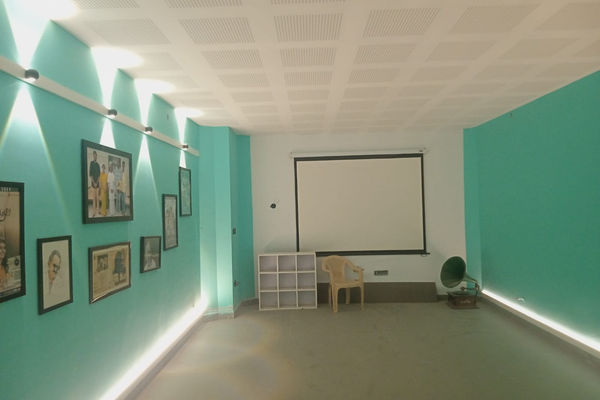


- Home
- Designs
- Room Designs
- Home Theatre
Showing 6 results for
Home Theatre Designs
A home theatre is an area within a home dedicated to emulating the immersive experience of a movie theatre. A family room is where you find a large screen or projector, high-quality audio, comfortable seating, and special lighting-all enhancing your viewing experience. If designed correctly, the home theatre establishes a balance of entertainment, comfort, and luxury. The homeowner can experience the movies, sports, and games in a private, cinematic experience that becomes immersive and enjoyable.
 Call McCoy Mart
+91 8010407407
Call McCoy Mart
+91 8010407407
Are you sure you want to exit?
You haven’t completed the form yet. If you leave now, your progress will be lost.
Mon-Sat 9:30AM to 6:30PM
Best Home Theater Design Ideas
Home theatre design is much more than just putting up a big screen and a few speakers in a room; it is creating an immersive movie-watching experience that brings the magic of the cinema into the comforts of your home. Whether you are designing a dedicated home theatre room or redesigning an existing room for multi-purposes, design plays a very vital role in defining your viewing experience and audio.
In today's world, we increasingly find ourselves desiring that experience of the cinema, but with the comforts and privacy we've come to know at home. Home theatre design actually plays a very big role in enhancing those comforts and immersive experience.
Importance of Home Theater Designs
Home Theatre Designs serves that purpose by creating an aesthetic allure to the surrounds and engaging entertainment for the viewers that guarantee comfort, function, and immersion beyond measure. Proper home theatre design guarantees that the place is both a venue for entertainment and enjoyment. Unlike just putting a TV in one corner and a soundbar plugged in, you do want to create an environment that actually enhances the viewing experience.
Here are some of the reasons why home theatre design matters:
Best Viewing: Placement of screens, seating, and sound systems can maximize your viewing pleasure. Design brings one closer to the direction and sound size, assuring one need never miss an angle for an in-house movie view.
Past the Rear Wall: Soundproofing and acoustic treatment done correctly can give your room amazing possibilities: they can make a welcoming bubble of clean, rich, and balanced audio. Much of the home-viewing experience comes down to the aesthetic, and it can be a transformative experience only with a good sound system in the room.
Comfort: With the seating position, ambient temperature, and lighting well selected, comfortable viewing is assured. With the long-running features, the couch must be comfortable to enjoy the thrill.
Property Values: A well-planned home theater attracts interest and enhances resale value. Potential buyers are going to be interested at the prospect of a home cinema room already laid out and ready for business.
Advantages of Home Cinema Room
Home cinema offers numerous benefits compared to the common living room arrangement, furnishing a personal immersive experience. While creating a private cinema, you can bombard yourself with joys of shoes, movies, and sports in all capacities, as far away from the noise of the outside world. Below are some of the main advantages to be enjoyed by creating your own home cinema room:
Personalization: One of the most highlighted examples of advantages of having a cinema room at one's disposal is personalizing one's entertainment. It entails creating your space with a giant screen, surround sound, and convenience, or being able to stream that Netflix show with wherever you want to take it.
High-Quality Audio and Visuals: A dedicated home theatre allows you to enjoy all contemporary audiovisual technologies, from 4K to 8K with surround sound systems.
Flexibility and Convenience: Having a home cinema room, you can choose whatever you want to watch, whenever you want and without having to leave the comfort of your house. With family movie nights, a friends game night, or just watching on your own all possible activities, and all available in a room that suits your requirements.
Entertainment for Everyone: From a family film night to a game night with friends or a snuggly night with family, a home cinema room provides entertainment for the whole family.
Enhanced Relaxation: There is a perfectly valid room for staying nice and relaxed in the home theatre, a room that feels like an escape. Comfort in the seating, immersive sounds, with appropriate lighting engender an environment which aids in putting you at ease and listening to the experience.
Understanding Home Theatre Design
Home theatre design is not a matter of expensive gizmos and expensive-looking furniture. It’s about creating an environment that combines comfort, style, and functionality. Thoughtful design incorporates elements like screen placement, sound systems, seating arrangements, and lighting. Let’s dive deeper into these components.
What Defines Home Theatre Design?
Home theatre design is based on the construction of an engaging audiovisual environment, similar to a movie theatre, such as a commercial cinema. The space must be aesthetically pleasing, acoustically intact and pleasant. Key elements that define a home theatre include:
A Large Display Screen or Projector: The screen is the focal point in any home cinema system. Whether you choose an LED, OLED, QLED TV, or a projector and screen setup, it plays a key role in creating a cinematic experience.
Powerful Sound System: A high quality sound system which provides uncompromised and full rich sound quality is critical to home theatre. Sound design can be used to induce the feeling of immersion and to make the user feel "in the middle of the action.
Comfortable Seating Arrangements: You’ll be spending hours in the home theatre, so comfortable seating is a priority. From plush recliners to theater-style seats, choose seating that allows for optimal comfort during extended movie sessions.
Appropriate Lighting: The correct lighting plays a critical role in creating the atmosphere for home cinema. Ideally, ambient lighting should be in harmony with the general ambience and improve the viewing experience without interfering.
Key Elements of a Home Cinema Room Designs
\When designing the optimal home cinema the user needs to take into account several factors. These elements not only work together to create an immersive cinematic experience but also contribute to the functionality and aesthetics of the room. Let's each examine the fundamental features of home theatre design:.
1. Screen and Projection System
The screen is the heart of the home cinema and the choice of display technology is one of the most important decisions in the creation of an ideal viewing experience. For larger rooms, projectors can create massive screens, while for smaller spaces, a large flat-screen TV may be the perfect choice.
LED, OLED, or QLED TVs: Such displays provide an fantastic visual fidelity and are ideal for such small rooms or very small areas with poor natural light. OLED, in particular, provides deep blacks and rich contrast, making it ideal for a home cinema setup.
Projectors and Screens: If you're aiming for the ultimate home cinema experience, projectors offer a larger-than-life screen size. Nowadays there are projectors equipped with high definition and ultra-high definition (4K, 8K) resolution which are comparable to commercial cinemas.
Screen Size and Placement: The size and position of your screen is something that needs to be thought about very carefully. In general, the screen should be about 1.5 times the distance of your seating, ensuring that the viewer has a comfortable and immersive visual experience.
2. Sound System
A high-quality sound system is what truly brings the cinema experience to life. In a home cinema, sound systems typically consist of surround sound, subwoofers, and sometimes even advanced technologies like Dolby Atmos. To achieve a cinema-like experience, the sound of space is distributed uniformly across the room, i.e., no matter where you sit, you can enjoy an immersive auditory experience.
5.1 or 7.1 Surround Sound System: These set-ups are typical for home theaters, using 5/1 (speaker 1 subwoofer) or 7/1 (speaker 1 subwoofer) speakers and a subwoofer to achieve surround effects around listeners.
Dolby Atmos: This is the next step in surround sound, with speakers located on top of the users to create a 3D sound setting. Its effect is to give a three dimension to the sound, to sense that sound is coming from above or all around.
Soundbars: Soundbars are a good solution for small spaces and those limited by budget. They offer excellent audio quality and are considerably simpler to set up than a complete surround system.
3. Seating Arrangements
Pleasant seating is of primary importance in obtaining an excellent home cinema experience. You’ll likely be watching movies for hours, so having the right seats can significantly enhance your enjoyment. There are several seating options to consider:
Recliner Chairs: These are the best comfort, in that you can fully recline and relax.
Sectional Sofas: Large sectional couches are great for family-friendly home theatres. They have lots of seating room to everyone but remain intimate.
Theater-Style Seating: Prefer a more vintage movie theater experience, choose tiered, stadium seating, where each row is above the next in a slight elevation to maximize sightlines.
4. Lighting Design
Lighting is very important in setting the right scene for your home theater. The aim is to generate soft, unobtrusive ambient lighting that does not compromise the viewing experience. Here are a few lighting solutions:
Dimmable Lighting: Recessed lighting, dimmable sconces or LED stripes can be deployed for the purpose of modifying the atmosphere.
Backlighting: Installing LED backlighting behind a TV or projector screen will reduce eye fatigue and improve contrast.
Accent Lighting: Highlight particular areas, e.g., pictures or the playing of the movie on the screen, with small spotlights (or LED lights) in a stylish way.
Home Theatre Design Ideas for Every Space
However, home theatre is able to match any area, no matter how modest your basement, spare bedroom, or living room may be. We'd like to discuss a variety of design concepts for rooms of different sizes and shapes.
Large Home Theatre Room Design Ideas
Fortunate are those with a large space from which possibilities are unbounded. A well sized home theatre room provides the optionality to achieve a full immersion, mimicking a commercial movie house.
Projector and Screen Setup: When it comes to a comprehensive viewing experience, a projector and a screen are the only right choices. Consider an ultra-wide screen for true cinematic visuals.
Multiple Rows of Seating: Stadium-style seating is a popular choice for large spaces. Upon developing a staggered rows system it is guaranteed that all the guests will be able to see the screen unobstructed.
Acoustic Panels: In the case of fairly large rooms, sound will radiate off the walls and become distorted. Acoustic panels or soundproofing materials, have the ability to preserve the quality of your audio, making it clear and crisp.
Elevated Seating: In order to achieve good experience, the back seats of seating should be lifted up to optimize the sight lines that can enjoy a good view. This ensures that whatever way you look there is no occlusion of the screen.
Small Home Theatre Room Design Ideas
It can also be a great home theater, since room is relatively small. If you are good at design, it will be possible to create a feeling of coziness, but it will still be immersive.
Wall-Mounted TV: One of the main advantages is that a large, wall-hung, flat-panel TV reduces the size and maximizes the beautiful look. It also enables one to remain with out the need for the room to be cluttered with bulky furniture.
Compact Sound System: A smaller room doesn’t need a huge sound system. It is possible to achieve an immersive set of conditions using either a standard high-performance soundbar or a compact surround-sound system, without taking up much space.
Adjustable Seating: Flexible seating is an ideal option for a small room. Sectional sofas, which can adapt to fit into a variety of spaces, when not in use can help with space saving.
Multi-Functional Home Cinema Room Design
When planning a space for multiple functions, here are some design ideas that will maintain your home theater room functional but adaptable:
Hidden Projector Screens: For the projector screen one might think of a retractable projector screen that is stowed when not viewing. This offers the flexibility to work, during the day, as a room or a workspace and in night time, as a cinema zone.
Convertible Furniture: Find furniture, which is able to serve a (multi)purpose in its idle version. Foldaway chairs or modular seating systems that can be reconfigured are ideal for narrow spaces.
Smart Home Integration: Smart lighting and media control that allows you to effect the room ambience by a single push of a button.
Home Theatre Design Styles
The design of your home cinema should reflect your personal taste, be it sleek modernist, classic cinematic, or even opulent. Following are some of the most popular home theater designs:
1. Minimalist Home Theatre Design
Minimalist style is characterized by pure lines, an objective design, and minimalism. This setting is just right for users who are after a streamlined, sleek movie experience without all that this space can still offer. Features of a minimalist home theatre include:
- Frameless Screens: A wide screen with a thin bezel border works to give a sleek appearance.
- Hidden Equipment: Electronics can be concealed from sight in cabinets or wall recesses to provide a sleek finish.
- Neutral Color Scheme: Select a colour scheme of black, white, and grey, using achromatic colour to produce a minimalist, sleek look.
2. Luxury Home Cinema Room Design
For those who want to make their home theatre an experience of opulence and comfort, a luxury design is the way to go. Key features of luxury home cinemas include:
- Plush, Reclining Seating: Deep velvet or leather reclined chairs with inbuilt cup holders and footrests provide a luxurious feel.
- Elegant Finishes: Rich wood paneling, chandeliers and ornate molding that add to the surroundings' beauty", etc.
- High-end Audio and Visual Equipment: Acquire the best-in-class gear, e.g., implementations of Dolby Atmos surround sound, 8k projectors, to immerse the audience.
3. Modern and Contemporary Home Theatre Designs
This approach relies on the latest technology and minimal design schemes to achieve a contemporary home theatre that is also stylish and functional. Features include:
- Smart Home Features: Automated lighting, voice control and smart media systems, contribute to a more comfortable experience.
- Geometric and Clean Design: Contemporary home cinemas are characterized by minimalism, geometric forms, and a plethora of glass or metal detailing.
- LED Lighting: Add LED lighting strips that have varying mood and effect capabilities.
4. Vintage or Classic Movie Theatre Design
A retrogressive home cinema room creates the familiar atmosphere of old movie houses in the privacy of the home. Red velvet-like seats, old movie stills, and antique-style accoutrements. Key features include:
- Traditional Movie Theater Seating: Velvet-covered chairs and classic film seats provide it with an old-fashioned look.
- Retro Decor: Movie props, antique popcorn machines and vintage movie posters to scale, make going to the movies more pleasurable.
- Theatrical Lighting: Install sconces and chandeliers in the style of those found in old movies.
Acoustic Considerations for Your Home Cinema
Sound is so vital as sight for a home cinema immersive experience, as it is. Proper acoustic design guarantees the high standard of audio quality just as according to the picture quality. Here are some key considerations:
Importance of Soundproofing
Soundproofing a home theatre room stops the sound of the room escaping and stops residents from disturbing others in the house. It further reduces external noise that could disrupt your movie-watching. Consider soundproofing solutions like:
- Thick Carpeting or Rugs on the floor.
- Acoustic Wall Panels to absorb sound.
- Closing gaps along the perimeter around windows and doors to mitigate sound leakage.
Acoustic Treatments for Better Sound Quality
Of course, obtaining the desired quality of sound is not just a case of putting in some sound system. Acoustic treatments are applied to enhance sound by reducing reverberation and sound degradation. Some options include:
- Bass Traps to control low-end frequencies.
- Acoustic panels that are attenuating to mid and high frequencies, acoustically enhancing sound clarity.
- Diffusers to evenly distribute sound throughout the room.
Home Cinema Interior Design
The décor of your home theatre can add to or detract from the overall experience. Using the correct furniture, wall coverings and lighting, one can have a room with a comfortable, pleasant appearance.
1. Creating the Right Ambience
Ambient lighting, comfortable seating, and acoustics help to build the ideal environment. The proposal is to provide the viewers with a comforting and friendly environment, i.e., placing the users in a setting that is right and making them able to dive into the movie world.
2. Choosing the Right Furniture for Comfort and Style
Your furniture should be both stylish and comfortable. Seek out seating that can handle extended movies, with luxuriously soft seating, and reclining seats for maximum comfort.
3. Wall Colors and Finishes for Your Home Theatre
Movies are viewed in home cinemas in deep, dark tones like navy, charcoal, or black. These colours diminish screen shine and enhance contrast. A matte surface is preferred screen wall and ceiling treatment to minimize reflections so that the display can be easily viewed.
4. Budget-Friendly Home Theatre Design Ideas
Building an awesome home cinema isn't expensive, too. Making a wise or two choices, it is possible to create a beautiful environment without spending too much.
Home Theatre Room Design for Different Spaces
Designing a Home Theatre in a Basement
Basements are ideal for home cinemas due to their naturally, dark luminaire. However, you may need to fit in soundproofing and acoustic treatment in order to achieve a best possible view and sound quality. In addition, projectors are suitable to create an extremely large screen in basement spaces.
Creating a Cinema Room in a Living Room
Not having the luxury of a specialist room at hand, it is still possible to build a cinema in the living room. Imagine a gigantic flat-screen TV, speakers mounted on the wall, and reclining sectional sofas for a less casual but more enthralling kind of experience.
Designing a home cinema is a fun and fulfilling process that can revolutionise your viewing pleasure. If you see the screen, sound system lighting, etc, then you can create a space you like. Whether you’re building a dedicated home theatre room or designing a versatile space that serves multiple purposes, there are endless possibilities to explore.
By investing in thoughtful design and contemporary technology, your home cinema can be a place to experience many years of enjoyment of the cinema with family and friends. Creating a snug cocoon for viewing or building a lavish home theatre the options are unlimited by the limits of your mind. Begin to design your perfect home theatre now and get ready for an experience that will never be forgotten!
Factors to Consider When Designing a Home Theatre
Designing a home theater is not just a matter of choosing a screen and speakers,e.g. Several factors contribute to the quality of the potential immersive viewing experience, and should be considered carefully as they form the foundation of comfortable, working, immersive construction. Below are the key factors to focus on:
1. Room Size and Layout - Room size influences choice of equipment and seating plan. Larger rooms are favorable to the placement of projectors, whereas in room of limited size flat screen televisions are suitable for rooms of limited size. Seating arrangements should be designed to avoid blockage and to facilitate sightlines as much as possible and sound scattering so that all viewers are able to see easily.
2. Screen and Projection - When there is a need for multiple rooms, a projector and a screen can be used to have a cinema experience - especially if you are looking for a large format screen. For smaller rooms there will be particularly good success of high-end televisions (i.e., LED, OLED, QLED) on displaying impressive images. Display size should be scaled according to the distance from the screen to the viewer in a factor of 1.5 fold.
3. Sound System - A good sound system is an essential feature for immersive experience. To realize an omnidirectional audio surround sound system in the whole room, choose a 5.1 or 7.1 system. In Dolby Atmos, there is a height channel to the soundstage, and thus realism is increased.
4. Seating Arrangements - Comfort is paramount and the seating should support good screen visibility and loud speaker clarity. Recliners, sectional sofas, or stadium seating provide options based on the amount of space that the room has, as well as preference for groups. Seats should be located at an appropriate distance from the screen so as to obtain an optimal view of the screen.
5. Lighting Design - Proper lighting enhances the cinematic atmosphere. Dimmable light should be applied to avoid the screen from becoming too bright and backlighting should be applied to reduce eye strain. It is already possible to introduce both accent and ambient lighting in such a way that it evokes a cosy ambiance without compromising an eligible representation.
6. Acoustic Treatment - Sound quality is influenced by the room's acoustics. Acoustic panels can be employed to damp echo and improve intelligibility, and bass traps to remove low frequencies. Soundproofing the room also helps reduce external noise interference.
7. Budget and Customization - Your budget will determine the equipment and design options available. For the lower-cost investment, installation packages might only require a bare-bones flat-screen TV and mono-speaker system, however for a higher budget the high-end of projectors and speakers could be supplied, and custom-designed furniture. Balance quality with affordability to meet your needs.
The design of a home theater is an investment into building an immersive space in which to watch the magic of the cinema, without the need to step out of the house. Based on the space scale, room layout, screen, projection, audio system, seating, lighting, and acoustic treatment, it is possible to design a specific space which can be optimized to provide a better watching experience. Specific, delicate conceptualization is not only about making things more comfortable and practical, but it is also about a beautiful, interactive, aging life environment, which family can cherish and play with for a long time.
FAQS
Q.1. What is the ideal room size for a home theatre?
A.1. Given the available equipment the size of the room is maximized but in all but a small number of instances floor space of 12 ft X 15 ft is sufficient to satisfy most home theatre installations. In cases of big rooms it will be possible to mount projectors, but in cases of the small rooms the best solution will be a big screen TV system.
Q.2. How much does it cost to set up a home cinema?
A.2. The cost can vary widely depending on your choices. There is a good balance between price point and specification for one tier of systems that will range in order of magnitude from Rs 2,00,000-5,00,000 and a professional high-end, fully equipped home theatre system with a power enhancement substrate, high-end projectors, speakers and custom-created seating systems exceeding Rs.20,00,000.
Q.3. What are the essential components of a home theatre system?
A.3. The main units are, screen/projection, surround sound or soundbar), furniture, and lighting. Further enhancements in immersion though acoustic control and smart home integration are also possible.
Q.4. What type of seating is best for a home theatre?
A.4. Reclining chairs or sectional sofas are most comfortable to use while watching long exposures of the screen. Tiered theater-style seating is an additional possibility for a cavernous room.
Q.5. How do I choose the right screen size for my home theatre?
A.5. The screen distance in meters should be 1.5 times larger than viewing distance in meters. [For instance] the program should be viewed at a distance of up to 10 ft and in this case the 75 in model is to be purchased.
Q.6. What type of lighting is best for a home theatre?
A.6. The best form of lighting for a home theatre is ambient lighting. Ambient, dimmable lighting with mechanical control is best. It is possible to illuminate the backlight and accent lights in a way which does not only result in a brighter experience, but also in having a lower amount of glare.
Q.7. How do I soundproof my home theatre?
A.7. Aural treatment (acoustic panels to wall, deep carpet(s)/rug(s) to floor and glazed wall insulated window unit to reduce sound transmission).
Q.8. Where can I find home theatre design inspiration?
A.8. Consumer online communities, e.g., Pinterest, McCoy Mart, and home theater aficionados, are wonderful settings for conceptual design ideas and inspiration.
Q.9. Do I need to hire a designer to create and install my home theater system?
A.9. While in principle reproducible, it can be reliably stated that sound and visual installations, along with suitable optimization, are performed by a technician.
Q.10. What are the latest trends in home theatre design?
A.10. Smart home integration, 8K resolution screens, and Dolby Atmos audio are some of the latest trends in home theatre technology and design.
 Call support
Call support
 Mail us at
Mail us at
 Address
Address
Registered Office
C-55, Pocket C, Phase-I, Okhla Industrial Estate, New Delhi, Delhi 110020
Corporate Office
IHDP Business Park, 3rd Floor, Plot No-7, Sector-127, Noida, UP 201304
 Call McCoy Mart
+91 8010407407
Call McCoy Mart
+91 8010407407



























